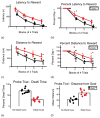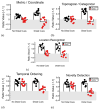Adaptation of the Arizona Cognitive Task Battery for use with the Ts65Dn mouse model (Mus musculus) of Down syndrome
- PMID: 28333487
- PMCID: PMC5552447
- DOI: 10.1037/com0000069
Adaptation of the Arizona Cognitive Task Battery for use with the Ts65Dn mouse model (Mus musculus) of Down syndrome
Abstract
We propose and validate a clear strategy to efficiently and comprehensively characterize neurobehavioral deficits in the Ts65Dn mouse model of Down syndrome. This novel approach uses neurocognitive theory to design and select behavioral tasks that test specific hypotheses concerning the results of Down syndrome. In this article, we model the Arizona Cognitive Task Battery, used to study human populations with Down syndrome, in Ts65Dn mice. We observed specific deficits for spatial memory, impaired long-term memory for visual objects, acquisition and reversal of motor responses, reduced motor dexterity, and impaired adaptive function as measured by nesting and anxiety tasks. The Ts65Dn mice showed intact temporal ordering, novelty detection, and visual object recognition with short delays. These results phenocopy the performance of participants with Down syndrome on the Arizona Cognitive Task Battery. This approach extends the utility of mouse models of Down syndrome by integrating the expertise of clinical neurology and cognitive neuroscience into the mouse behavioral laboratory. Further, by directly emphasizing the reciprocal translation of research between human disease states and the associated mouse models, we demonstrate that it is possible for both groups to mutually inform each other's research to more efficiently generate hypotheses and elucidate treatment strategies. (PsycINFO Database Record
(c) 2017 APA, all rights reserved).
Conflict of interest statement
All authors declare they have no competing financial or professional interests.
Figures






Similar articles
-
A comparative neuropsychological test battery differentiates cognitive signatures of Fragile X and Down syndrome.J Intellect Disabil Res. 2009 Feb;53(2):125-42. doi: 10.1111/j.1365-2788.2008.01135.x. Epub 2008 Nov 27. J Intellect Disabil Res. 2009. PMID: 19054268
-
Dentate gyrus mediates cognitive function in the Ts65Dn/DnJ mouse model of Down syndrome.Hippocampus. 2014 Mar;24(3):354-62. doi: 10.1002/hipo.22229. Epub 2013 Dec 13. Hippocampus. 2014. PMID: 24339224 Free PMC article.
-
Evidence that increased Kcnj6 gene dose is necessary for deficits in behavior and dentate gyrus synaptic plasticity in the Ts65Dn mouse model of Down syndrome.Neurobiol Dis. 2017 Jul;103:1-10. doi: 10.1016/j.nbd.2017.03.009. Epub 2017 Mar 22. Neurobiol Dis. 2017. PMID: 28342823 Free PMC article.
-
Object recognition memory is conserved in Ts1Cje, a mouse model of Down syndrome.Neurosci Lett. 2007 Jun 27;421(2):137-41. doi: 10.1016/j.neulet.2007.04.075. Epub 2007 May 29. Neurosci Lett. 2007. PMID: 17566652
-
Effects of chronic administration of SGS-111 during adulthood and during the pre- and post-natal periods on the cognitive deficits of Ts65Dn mice, a model of Down syndrome.Behav Brain Res. 2008 Apr 9;188(2):355-67. doi: 10.1016/j.bbr.2007.11.020. Epub 2007 Dec 3. Behav Brain Res. 2008. PMID: 18178265
Cited by
-
Challenges and Opportunities for Translation of Therapies to Improve Cognition in Down Syndrome.Trends Mol Med. 2020 Feb;26(2):150-169. doi: 10.1016/j.molmed.2019.10.001. Epub 2019 Nov 7. Trends Mol Med. 2020. PMID: 31706840 Free PMC article.
-
Visual discrimination and inhibitory control deficits in mouse models of Down syndrome: A pilot study using rodent touchscreen technology.J Neurosci Res. 2023 Apr;101(4):492-507. doi: 10.1002/jnr.25160. Epub 2023 Jan 5. J Neurosci Res. 2023. PMID: 36602162 Free PMC article.
References
-
- Bannerman D, Deacon R, Offen S, Friswell J, Grubb M, Rawlins J. Double dissociation of function within the hippocampus: spatial memory and hyponeophagia. Behavioral Neuroscience. 2002;116(5):884. - PubMed
-
- Baumann O, Chan E, Mattingley JB. Distinct neural networks underlie encoding of categorical versus coordinate spatial relations during active navigation. Neuro Image. 2012;60(3):1630–1637. - PubMed
-
- Benjamini Y, Drai D, Elmer G, Kafkafi N, Golani I. Controlling the false discovery rate in behavior genetics research. Behavioural Brain Research. 2001;125(1):279–284. - PubMed
MeSH terms
Grants and funding
LinkOut - more resources
Full Text Sources
Other Literature Sources
Medical

